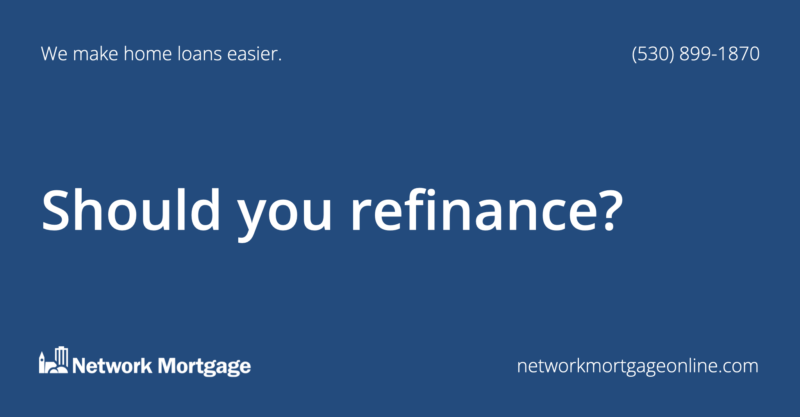While refinancing can be the right choice, keep in mind that trading your existing home loan for a new one isn’t always the best solution. There are a few scenarios when a refinance might not be such a good idea.
When to refinance. And when not to.
You probably already know the basics, but let’s quickly review. A mortgage refinance is when you take out a new home loan to pay off and replace your old loan. Common reasons to refinance are to lower the monthly interest rate, lower the mortgage payment, or to borrow additional money.
When mortgage rates are falling, it might seem like a good time to refinance your home — to lower your loan payments or tap into some of the equity you’ve built up.
But while refinancing can be the right choice, keep in mind that trading your existing home loan for a new one isn’t always a great idea — For a lot of reasons.
Let’s take a look at the pros and cons of mortgage refinancing from a purely practical perspective. Obviously, you may have a scenario that’s not mentioned here, so be sure to consult with a mortgage expert before you make any final decisions.
When to refinance your mortgage
Refinancing a home loan can be a smart financial move under many circumstances. Here’s a few situations when it might be a good time to refinance.
01. Lower interest rates
If mortgage interest rates have significantly dropped since you obtained your last mortgage, refinancing to a lower interest rate can lead to lower monthly payments — and substantial savings over the life of the loan.
02. Improved credit score
If your credit score has improved since you got your current mortgage, you might qualify for a better interest rate. A higher credit score demonstrates lower risk to lenders — resulting in more favorable terms.
03. Switching loan types
If you’re currently on an adjustable-rate mortgage (ARM) and want to lock in a more stable monthly payment, refinancing to a fixed-rate mortgage can provide peace of mind, especially if interest rates are low.
04. Shortening the loan term
If you’re in a financial position to make higher monthly payments, refinancing to a shorter loan term (say from 30 years to 15 years) can help you pay off your mortgage faster and save on overall interest costs.
05. Need for cash
If your home has gained significant value since you bought it, you might be able to refinance and take out some of the equity as cash. This can be useful for home improvements, debt consolidation, or other financial needs.
06. Get rid of PMI
If you initially put less than 20% down on your home, you might be paying for private mortgage insurance. If your home’s value has increased or you’ve paid down your mortgage enough, refinancing could help you eliminate the need for PMI.
07. Better loan terms
If your current mortgage has unfavorable terms — such as a balloon payment or prepayment penalties — refinancing can help you move to a more straightforward and borrower-friendly loan.
08. Long-term home ownership
If you plan to stay in your home for an extended period, the upfront costs of refinancing might be justified by the long-term savings in interest payments.
What about credit card debt?
For some situations, paying off high-interest credit card debt with low-interest mortgage debt can be a good strategy. To wipe out your credit card balances, you’ll need to do what’s called a cash-out refinance: You borrow more than you owe on your home and take out the extra in cash.
That money goes to your card issuer. You’ll be left with a larger mortgage and larger monthly payment. However, you need to be absolutely certain you’ve conquered your reliance on plastic. If you get in over your head with your credit cards all over again, you could put your house at risk.
When not to refinance your mortgage
Now that we’ve looked at some of the pros of refinancing, let’s review a few situations where it may not be such a great idea.
01. Higher interest rates
If interest rates have increased since you initially got your mortgage, it might not be a good time to refinance. Refinancing when rates are higher could mean you end up with a larger monthly payment than what you currently have.
02. High closing costs
Refinancing involves closing costs, which can add up to a significant amount. If the closing costs are high and you’re not planning to stay in the home long enough to recoup those costs through lower monthly payments, refinancing might not be financially beneficial.
03. Short time remaining on the loan
If you’re close to paying off your mortgage, refinancing might not make sense. The costs and fees associated with refinancing could outweigh the potential benefits of a lower interest rate.
04. Planning to move soon
If you’re planning to sell your home in the near future, the cost of refinancing might not be recouped by the potential savings in interest payments. It takes time to start realizing the savings from a lower interest rate, so if you’re not going to stay in the house long enough, it may not be worth it.
05. Poor credit
Refinancing typically involves a credit check, and if your credit score has significantly decreased since you initially obtained your mortgage, you might not qualify for favorable refinance rates. In this case, refinancing could actually result in higher interest rates, negating any potential benefits.
06. Hefty prepayment penalties
Although uncommon these days, some mortgages come with prepayment penalties — fees you have to pay if you pay off your mortgage early. Refinancing might trigger these penalties, making the process less cost-effective.
07. Financial instability
If you’re facing financial challenges, such as a job loss or reduced income, refinancing might not be a wise decision. It could extend your loan term or increase your monthly payments, adding financial stress during an already difficult time.
08. Switching to a riskier loan type
If you’re considering switching from a fixed-rate mortgage to an adjustable-rate mortgage (ARM), or vice versa, make sure you understand the potential risks. If you’re uncomfortable with the uncertainty of an ARM’s future interest rate adjustments, it might not be the right move.
09. You don’t meet equity requirements
Some lenders require a certain amount of home equity (the difference between your home’s value and what you owe) to qualify for refinancing. If you don’t meet these requirements, you might not be able to refinance.
10. You want to invest in stocks and bonds
Investing in stocks, bonds and other assets can be a great way to build long-term wealth, but it’s very risky to invest with equity pulled from your home in a cash-out refinance.
For the modest earnings on “safe” investments like certificates of deposit, refinancing is hardly worth the effort. And the more lucrative investments can involve considerable risk: You could lose your money and be left with nothing but a bigger mortgage.
11. You’re tempted by a “no-cost” refinance
All mortgages come with fees and other costs that have to be paid. So, be skeptical when a lender claims to offer a “no-cost” or “low-cost” refinance. These heavily-marketed loans hide all the closing costs — The fees may be rolled into your loan amount, or be passed on to you in the form of a higher interest rate.
Summary
Before refinancing, it’s important to carefully assess your individual financial situation, calculate potential savings, and consider how long it will take to recoup the closing costs through reduced monthly payments.
Consulting with a financial advisor or mortgage professional (we know a few) can help you figure out if refinancing aligns with your financial goals and circumstances.
We can help
Trying to untangle your refinance options can get confusing. If you’d like to speak with some smart folks who can clear away the jargon and explain these loans in simple terms, please get in touch. You can ask us anything.
Related
- Debt consolidation loans
- Fixed vs. adjustable-rate mortgages
- Frequently asked questions
- Refinancing myths
- The Truth About “No Closing Cost” Mortgages
Resources
Last updated: August 28, 2023 at 5:13:05 PM PDT

